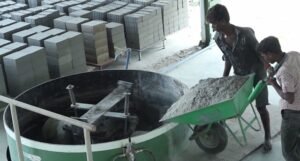In this article, we will address one of the most commonly asked questions about brick building materials, which is the difference between clay brick and cement brick. We will explore their unique characteristics and provide an answer to the question of which brick is better.
Clay Bricks:
Clay bricks, also known as red bricks, have been in use for over ten thousand years and are still prevalent today in residential, commercial, and industrial buildings. These bricks are made by combining clay, water, and aggregate.
Cement Bricks:
Cement bricks are building bricks made of cement, quarry dust, stone aggregates, fly ash, and other building materials. Despite being called cement bricks, they are not entirely composed of cement. They are also commonly known as concrete bricks in the industry, and they are more robust than clay bricks.
Cement bricks are increasingly popular in modern structures due to their simple and straightforward design, durability, and affordability. In contrast, clay bricks are still a preferred option for some residential and commercial buildings.
Now let’s examine the differences between clay brick and cement brick.
The Differences Between Clay Brick and Cement Brick:
In order to select the most suitable building material for a project, it is important to consider the differences in composition and application between clay bricks and cement blocks. Failure to do so may lead to negative outcomes in terms of cost and structure efficiency. Therefore, it is crucial to carefully select the appropriate material in the early stages of a project.
Both clay bricks and cement blocks are strong materials that are fire-resistant and long-lasting. However, their structural properties differ due to the use of different raw materials. Clay bricks are made by combining sand, lime, and concrete, and can be mixed with various additives to produce different types and colors. Cement blocks, on the other hand, are made from crushed sand or stone aggregate, which gives them high strength without the need for additional materials.
The differences between clay bricks and cement blocks are as follows:
- Cement bricks have a higher compressive strength than clay bricks due to the method of manufacturing and materials used. As a result, cement blocks are commonly used in high-rise buildings that require greater concrete strength.
- Cement bricks are highly waterproof, making them suitable for construction in wet and muddy environments. In contrast, clay bricks have low waterproofing and are susceptible to damage in damp environments, which can lead to mold formation.
- Cement bricks have a shorter lifespan than clay bricks, providing effective results for up to 100 years, while clay bricks can last up to 1000 years.
- The production of clay bricks depletes fertile soil and emits more carbon dioxide during the manufacturing process, making cement blocks more environmentally friendly since they are often made with fly ash instead of stone aggregates, and produce less CO2 emissions.
- Clay bricks have a more aesthetically pleasing appearance from an architectural standpoint, but they tend to emit metallic salts that cause paint to peel off. Cement blocks, on the other hand, can be enhanced to improve their exterior appearance and are easier to paint.
- Clay bricks are less expensive on their own, but their overall cost, including mortar and construction, is high since they require more mortar. Cement blocks are more expensive individually, but they require less mortar, and fewer of them are needed to construct the same wall area as clay bricks.
In summary, purchasing and logistics for cement blocks can be less expensive, and they can be made from reusable waste materials, making them more environmentally friendly. However, clay bricks have a higher lifespan, while cement blocks are highly waterproof and have a higher compressive strength. Clay bricks emit more CO2 during manufacturing and are less cost-effective due to higher mortar requirements.
Clay Brick Application:
Clay bricks, also known as red bricks, can be utilized in the construction of buildings, foundations, arches, pavements, and bridges. They can also be used for aesthetic purposes such as landscaping, facades, and other architectural designs.
Cement Brick Application:
Cement bricks are commonly used in construction as load-bearing and non-load-bearing walls, panel walls, and partition walls. They are also utilized for supporting piers, retaining walls, facing materials, chimneys, fireplaces, and garden walls, among other applications.
Which type of brick should you buy? Cement or Clay?
If you’re trying to decide between cement and clay bricks, it’s important to consider the type of construction and project requirements. As we discussed earlier, there are notable differences between the two types of bricks, and each has its advantages and disadvantages. Cement bricks are often preferred due to their lower cost and various benefits, especially when constructing high-rise buildings that require strong foundations and high concrete strength. Therefore, contractors and developers tend to choose cement bricks for such projects.



